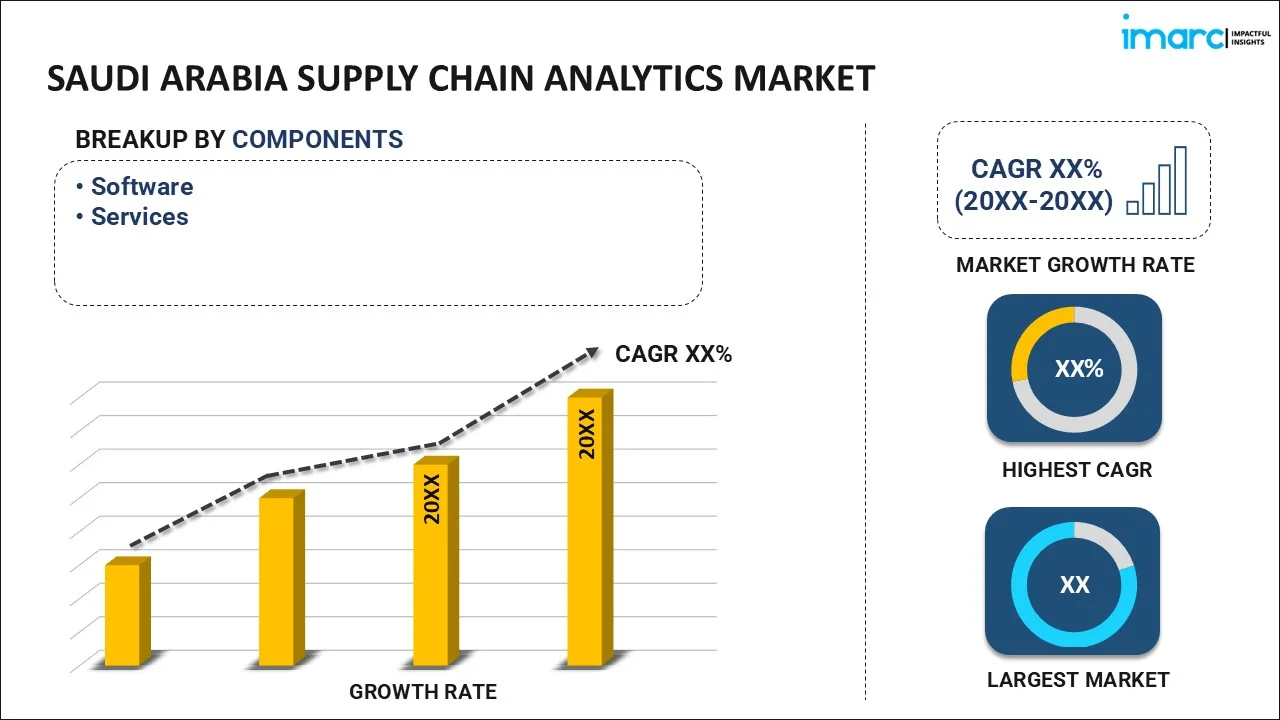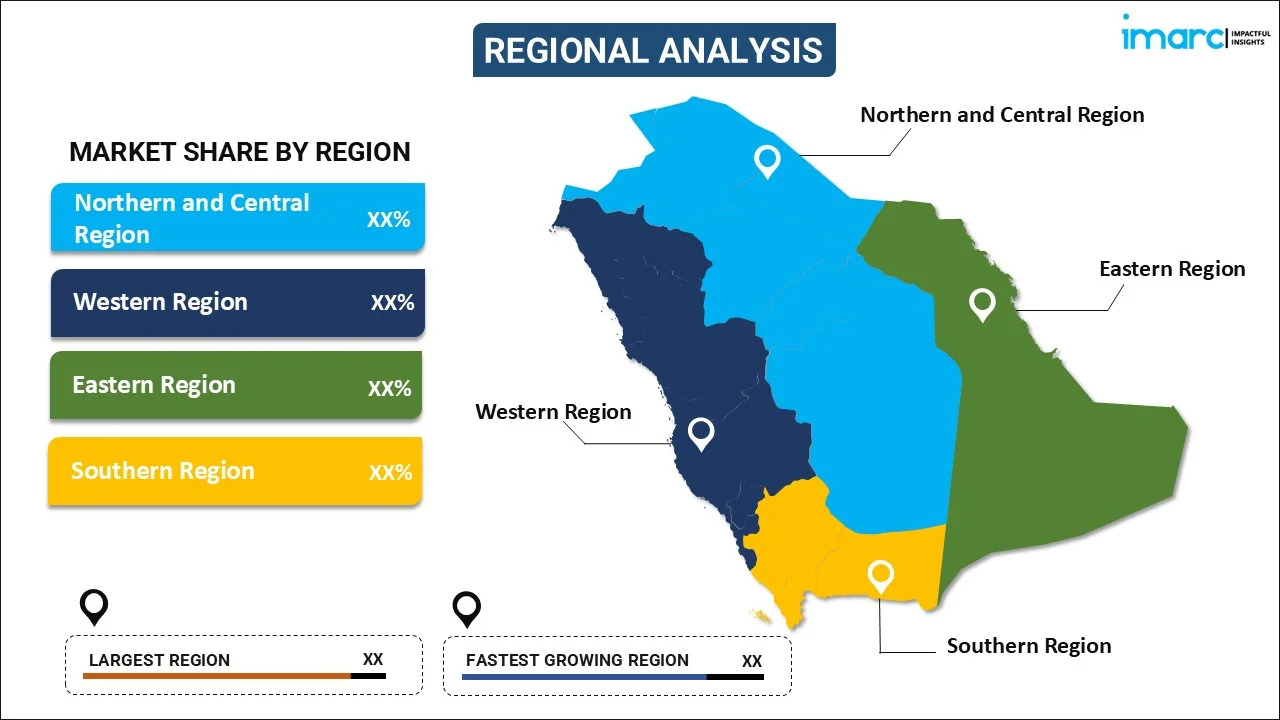
Saudi Arabia Supply Chain Analytics Market Size, Share, Trends and Forecast by Component, Deployment Mode, Enterprise Size, Industry Vertical, and Region, 2025-2033
Saudi Arabia Supply Chain Analytics Market Overview:
The Saudi Arabia supply chain analytics market size reached USD 0.09 Billion in 2024. Looking forward, IMARC Group expects the market to reach USD 0.35 Billion by 2033, exhibiting a growth rate (CAGR) of 16.72% during 2025-2033. The market is expanding swiftly, fueled by rising adoption of digital solutions to enhance logistics efficiency, inventory optimization, and real-time decision-making, reflecting the country’s strategic push toward data-driven industrial advancements.
|
Report Attribute
|
Key Statistics
|
|---|---|
|
Base Year
|
2024
|
|
Forecast Years
|
2025-2033
|
|
Historical Years
|
2019-2024
|
| Market Size in 2024 | USD 0.09 Billion |
| Market Forecast in 2033 | USD 0.35 Billion |
| Market Growth Rate (2025-2033) | 16.72% |
Saudi Arabia Supply Chain Analytics Market Trends:
Increased Adoption of AI and Machine Learning in Analytics
The increasing integration of artificial intelligence (AI) and machine learning (ML) technologies, driven by the need for predictive insights and automation is favoring the Saudi Arabia supply chain analytics market growth. Organizations utilize these instruments to analyze massive datasets, better forecast demand, and detect inefficiencies in the supply chain in real time, thereby enabling healthier operations overall. With the growing implementation of artificial intelligence and machine learning in various supply chain activities, Saudi Arabian companies and government entities are investing in advanced software and skills development to help create predictive and predictive models that help improve logistics, inventory and demand forecasting, optimize operational efficiency and reduce costs. For instance, according to a latest industry report from 2024, Saudi Arabia announced its plan to invest USD 6.4+ Billion (approximately SAR 24 billion) to enhance next-generation technologies and entrepreneurship. This trend aligns with Vision 2030's push for digital transformation, as companies across retail, manufacturing, and logistics adopt advanced analytics to stay competitive.
Rising Focus on Real-Time Data Analytics for Logistics
Saudi Arabia’s supply chain analytics market is witnessing a trend toward real-time data analytics as companies seek instant insights to manage logistics more effectively. The emphasis on real-time data reflects the need for enhanced transparency and agility, particularly as the e-commerce and retail sectors, along with startups, supports Saudi Arabia supply chain analytics market share. For instance, according to industry reports, in 2023, Saudi Arabia’s e-commerce startups attracted SR1.6 Billion (USD 426.7 Million) in venture capital funding. Additionally, real-time analytics provide logistics managers with immediate updates on shipment locations, inventory levels, and potential disruptions, enabling quicker decision-making. This trend is driven by the region’s growing logistics sector, where real-time data is crucial for meeting customer expectations in an increasingly digital economy. As a result, more companies are adopting technologies that integrate real-time analytics into their supply chain systems, ensuring efficient operations and heightened responsiveness.
Growing Demand for End-to-End Supply Chain Visibility
Organizations in Saudi Arabia are increasingly requiring end-to-end visibility across the supply chain, from production to delivery, and in the drive for transparency and traceability, ensuring operational efficiencies. This is especially significant in the healthcare, food, and manufacturing industries, where standards for quality control and regulatory compliance are very high. Companies are increasingly investing in advanced analytics platforms that provide rich, real-time insight across the whole supply network to mitigate risks, and also reduce delays and improve responsiveness. For instance, according to industry reports, in October 2023, NEOM and DSV made a USD 10 Billion joint venture to establish an exclusive logistics network supporting NEOM’s ambitious projects. The partnership provided end-to-end supply chain management, asset and infrastructure development, and efficient transport solutions within NEOM, illustrating Saudi Arabia’s commitment to modernization through robust supply chain solutions. Furthermore, investments in visibility-enhancing analytics align with the country’s modernization objectives and build resilience against potential disruptions in the changing Saudi market. Therefore, this is creating a positive Saudi Arabia supply chain analytics market outlook.
Saudi Arabia Supply Chain Analytics Market Segmentation:
IMARC Group provides an analysis of the key trends in each segment of the market, along with forecasts at the regional level for 2025-2033. Our report has categorized the market based on component, deployment mode, enterprise size, and industry vertical.
Component Insights:

- Software
- Demand Analysis and Forecasting
- Supplier Performance Analytics
- Spend and Procurement Analytics
- Inventory Analytics
- Transportation and Logistics Analytics
- Services
- Professional
- Support and Maintenance
The report has provided a detailed breakup and analysis of the market based on the component. This includes software (demand analysis and forecasting, supplier performance analytics, spend and procurement analytics, inventory analytics, and transportation and logistics analytics) and services (professional and support and maintenance).
Deployment Mode Insights:
- On-premises
- Cloud-based
A detailed breakup and analysis of the market based on the deployment mode have also been provided in the report. This includes on-premises and cloud-based.
Enterprise Size Insights:
- Large Enterprises
- Small and Medium Enterprises
The report has provided a detailed breakup and analysis of the market based on the enterprise size. This includes large enterprises, and small and medium enterprises.
Industry Vertical Insights:
- Automotive
- Food and Beverages
- Healthcare and Pharmaceuticals
- Manufacturing
- Retail and Consumer Goods
- Transportation and Logistics
- Others
A detailed breakup and analysis of the market based on the industry vertical have also been provided in the report. This includes automotive, food and beverages, healthcare and pharmaceuticals, manufacturing, retail and consumer goods, transportation and logistics, and others.
Regional Insights:

- Northern and Central Region
- Western Region
- Eastern Region
- Southern Region
The report has also provided a comprehensive analysis of all the major regional markets, which include Northern and Central Region, Western Region, Eastern Region, and Southern Region.
Competitive Landscape:
The market research report has also provided a comprehensive analysis of the competitive landscape. Competitive analysis such as market structure, key player positioning, top winning strategies, competitive dashboard, and company evaluation quadrant has been covered in the report. Also, detailed profiles of all major companies have been provided.
Saudi Arabia Supply Chain Analytics Market News:
- In March 2023, Aramco and DHL Supply Chain, an international contract logistics provider, partnered to launch Saudi Arabia’s first integrated procurement and logistics hub, focused on delivering end-to-end supply chain solutions for the industrial, energy, chemical, and petrochemical sectors. This joint venture streamlines procurement, inventory, and logistics management while enhancing sustainability and efficiency across Saudi Arabia and the MENA region.
Saudi Arabia Supply Chain Analytics Market Report Coverage:
| Report Features | Details |
|---|---|
| Base Year of the Analysis | 2024 |
| Historical Period | 2019-2024 |
| Forecast Period | 2025-2033 |
| Units | Billion USD |
| Scope of the Report |
Exploration of Historical Trends and Market Outlook, Industry Catalysts and Challenges, Segment-Wise Historical and Future Market Assessment:
|
| Components Covered |
|
| Deployment Modes Covered | On-premises, Cloud-based |
| Enterprise Sizes Covered | Large Enterprises, Small and Medium Enterprises |
| Industry Verticals Covered | Automotive, Food and Beverages, Healthcare and Pharmaceuticals, Manufacturing, Retail and Consumer Goods, Transportation and Logistics, Others |
| Regions Covered | Northern and Central Region, Western Region, Eastern Region, Southern Region |
| Customization Scope | 10% Free Customization |
| Post-Sale Analyst Support | 10-12 Weeks |
| Delivery Format | PDF and Excel through Email (We can also provide the editable version of the report in PPT/Word format on special request) |
Key Questions Answered in This Report:
- How has the Saudi Arabia supply chain analytics market performed so far and how will it perform in the coming years?
- What is the breakup of the Saudi Arabia supply chain analytics market on the basis of component?
- What is the breakup of the Saudi Arabia supply chain analytics market on the basis of deployment mode?
- What is the breakup of the Saudi Arabia supply chain analytics market on the basis of enterprise size?
- What is the breakup of the Saudi Arabia supply chain analytics market on the basis of industry vertical?
- What is the breakup of the Saudi Arabia supply chain analytics market on the basis of region?
- What are the various stages in the value chain of the Saudi Arabia supply chain analytics market?
- What are the key driving factors and challenges in the Saudi Arabia supply chain analytics?
- What is the structure of the Saudi Arabia supply chain analytics market and who are the key players?
- What is the degree of competition in the Saudi Arabia supply chain analytics market?
Key Benefits for Stakeholders:
- IMARC’s industry report offers a comprehensive quantitative analysis of various market segments, historical and current market trends, market forecasts, and dynamics of the Saudi Arabia supply chain analytics market from 2019-2033.
- The research report provides the latest information on the market drivers, challenges, and opportunities in the Saudi Arabia supply chain analytics market.
- Porter's five forces analysis assist stakeholders in assessing the impact of new entrants, competitive rivalry, supplier power, buyer power, and the threat of substitution. It helps stakeholders to analyze the level of competition within the Saudi Arabia supply chain analytics industry and its attractiveness.
- Competitive landscape allows stakeholders to understand their competitive environment and provides an insight into the current positions of key players in the market.
Need more help?
- Speak to our experienced analysts for insights on the current market scenarios.
- Include additional segments and countries to customize the report as per your requirement.
- Gain an unparalleled competitive advantage in your domain by understanding how to utilize the report and positively impacting your operations and revenue.
- For further assistance, please connect with our analysts.
 Request Customization
Request Customization
 Speak to an Analyst
Speak to an Analyst
 Request Brochure
Request Brochure
 Inquire Before Buying
Inquire Before Buying




.webp)




.webp)












